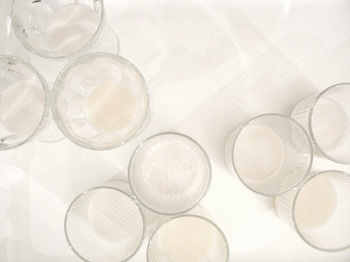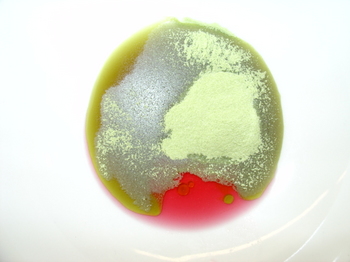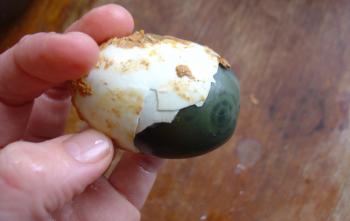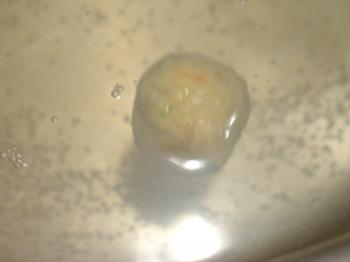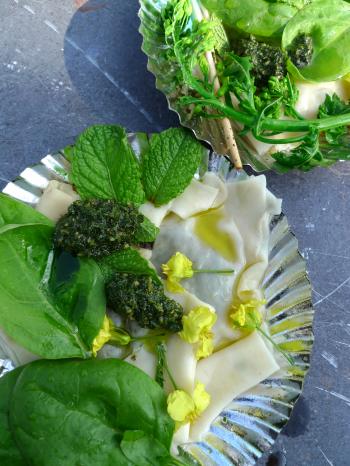A happy new year
for the fruit trees
February 10, 2009
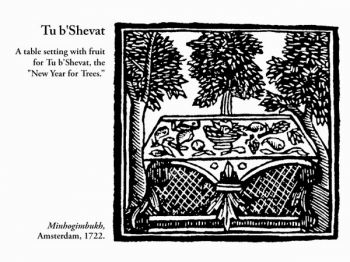
Woodcut for the Jewish arbor day Tu b’Shvat, from the Minhogimbukh Amsterdam 1722, recently adapted by Scott-Martin Kosofsky, image used entirely without permission.
There’s nothing like a religious calendar sporting multiple ‘new years’ to remind us that we were once deeply connected to our food systems. Agrarian celebrations lace the Jewish calendar commemorating inventory and tithing, sorting and sowing, fasting, harvesting, slaughtering, and all manner of specialized and neurotic food preservation. Ancestors, be happy, you left an indelible mark.
Tu b’Shvat is not a biblical holiday but comes from the Mishnah, the Jewish book of case-studies, aka the ‘Oral Torah’. At that time (about 2000 years ago) a tithe of fruit and vegetables used to be paid to landlords as a form of taxation. This was the time of year when the fruit tree inventory took place and the age of trees was determined. Somehow the 16th century Kabbalists of Tsfat transformed this into a festival by accompanying their prayers with wine & fruit, and the Jewish custom of celebrating paying taxes in fresh produce was born. What, how do you pay yours?
By now Tu b’Shvat is about tree-planting and other big fans of diaspora like me will appreciate the ‘bloom where you are planted’ angle on this holiday. I’m thinking that a good Tu b’Shvat resolution for those of us lucky enough to have fruit trees would be to make sure that the fruit of our trees doesn’t go to waste. If you can not eat and preserve it all by yourself, there are organizations that will help you do so, either by turning it into jams, chutneys, leather, and pies, or by donating the fruit to folks that don’t get their recommended 2 cups of fresh per day. I’ve listed some of these orgs in the notes below this entry. And if you yourself want to engage in some ad-hoc leather and jam, in L.A. the artist collective Fallen Fruit has made maps of the city’s fruit trees that can be harvested either voluntarily or less so.
My New Year for the Trees resolution will be to make dang sure to design fruit-bearing FEMALE trees into the public space occupied by my urban projects. I hadn’t really thought about the fact that landscape architects the world over were primarily planting MALE trees in our cities until I read Thomas Leo Ogren’s essay in Actions: What You Can Do With the City. He writes, Male trees grow no fruit, seeds, or seed pods, and thus are considered “litter-free.” From a caretaking point of view they are “low maintenance.” The human health impact is that our cities are filled with highly allergenic pollen producing, sperm-spewing males. Considering that allergies now affect some 40% of all urbanites, the obvious solution to this public health threat, and one whose spinoff could create jobs and micro-economies, is not just to blame the males but to plan and plant fruit-producing female trees.
If Channukah is the Jewish holiday of Peak Oil, then surely Tu B’Shvat is the Jewish holiday of urban agriculture! In the coming period of New Austerity, I predict that Tu b’Shvat will reach unprecedented secular popularity, resonating even more than… Purim! Remember, you read it here first.
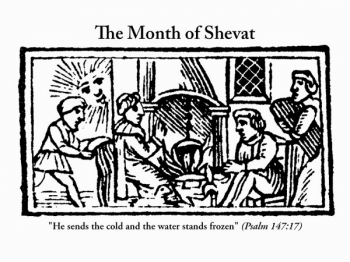
Woodcut for the month of Shvat, from the 1722 Amsterdam edition of the Book of Customs, now adapted by Scott-Martin Kosofsky, image used without permission
- Tu b’Shvat according to the hive brain of Wikipedia. If nothing else, a good starting point before spiraling out of control.
Scott-Martin Kosofsky’s newly adapted Book of Customs can be purchased here, here and here.
Village Harvest is a nonprofit suburban harvesting cooperative in Santa Clara Valley, California, which brings together neighbors and community organizations to provide food for the hungry, preserve our heritage and skills, and promote sustainable use of urban resources. But you can read about other organizations here and you can see a slideshow about urban gleaning here.
Artist collective Fallen Fruit were giving fruit trees away this last weekend, sorry I didn’t know about this earlier. Fallen Fruit maintain maps of urban fruit trees ripe and ready for picking in the LA area.
Want to take a certified course in Permaculture Design?
Here’s a list - for France anyway.Introductory essays by the editors Mirko Zardini and Giovanna Borasi provide historical perspective and establish the curatorial framework for the exhibition and publication. Original essays are contributed by Jochen Becker, Vikram Bhatt, Katrin Bohn, Brendan M. Brogan, Coloco, Henk Döll, Fergus the Forager, Omar Freilla, George J. Grella Jr., Fritz Haeg, Tali Hatuka, Dan Hill, Sarah Hill, Ocean Howell, Hans Ibelings, Momoyo Kaijima, David Ker Thomson, Zoe Laughlin, Sonia Lavadinho, Nina-Marie Lister, Alejandra López, Thomas Leo Ogren, Emily Rauhala, Richard Reynolds, Debra Solomon, Yoshiharu Tsukamoto, Jeroen van Nieuwenhuizen, and Andre Viljoen.
Co-published by Canadian Centre for Architecture, Montréal, and SUN, Amsterdam, the catalogue is designed by Novak, Amsterdam. The 240-page, soft-cover book includes 70 colour and black and white illustrations, and features a folded poster as cover wrap. The volume is available as of 1 December 2008 at the CCA Bookstore in English and French editions for $42.95 CAD/USD ISBN: 978-0-920785-82-9.
debra at 15:58 | | post to del.icio.us

